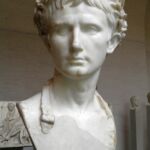A statue of a Roman holding the busts of his ancestors, the so-called “The Barberini statue” is one of the main examples of Roman portrait sculpture mastery of the ancient period. It was created during the reign of Emperor Octavian Augustus, but its form is not uniform, because it shows the stylistic changes of the Roman portrait of the second half of the 1st century BCE and consists of elements created in stages.
The entire sculpture was created during the reign of Emperor Augustus, as evidenced by the way the patrician’s toga is draped, i.e. the arrangement of its folds. The portrait held in the right hand comes from the 50-40 BCE, and the one in the left-hand dates to the years 20-15 BCE. The standing figure itself, although it was created in antiquity, has acquired its present form in modern times.
This work is described as a testimony to the realism of the ancient Roman portrait, which combines the verism of Roman bourgeois art with the idealizing approach typical of Greek psychological portraiture. Moreover, it refers to the tradition of death masks. The first stylistic tendency, that is verism, is visible especially in the face of a standing man, who objectively reflects the appearance and individual features of the model, taking into account his separate inner life, without any tendency to beautify. The idealization, characteristic of Greek art, is present in the portraits of ancestors, which are characterized by more subtle modelling, nobility and seriousness of features and represent “the masculine and austere ideal of traditional male virtue”. This idealization also results from the custom of paying tribute to the dead and the worship of one’s ancestors.
This form and meaning of the “Barberini statue” are related to the tradition of death masks, or imagines maiorum, which were probably used to create portraits of the ancestors held in the hands of the Roman statue. Imagines maiorum were to enable the memory of deceased members of Roman families to be preserved as long as possible. Wax masks, with great accuracy recreating the features of the deceased’s ancestors, were worn by participants in aristocratic funerals as early as the 2nd century BC. They were kept in wardrobes on a daily basis and were solemnly displayed in the atrium during holidays. Various materials were used to create them, terracotta or wood, and above all, wax, which became the most popular since around 300 BCE, when Lysistrata discovered the technique of casting the face in this material. Over time, wax masks began to be copied in stone to better preserve the precious features of the revered ancestors. This method strongly influenced the development of Roman portrait sculpture, mainly its realism and attention to detail.
The creator of this work remains anonymous, like most artists of antiquity. It is believed, however, that the authors of the most outstanding portraits of the era of Emperor Augustus, and the “Barberini statue” undoubtedly belongs to them, were Latinized Greeks. The differences in the way of facial formation visible in this sculpture testify to the influence of various schools of Hellenistic art, the common feature of which was to emphasize the individualism of the portrayed individual. This property is still a trace of pathos-mingled realism that was captured from Etruscan art.
The sculpture portrays the patrician and his ancestors from the Barberini family. In the era of the New Republic, i.e. during the reign of Emperor Augustus, patricians were a privileged social class that had the exclusive right to hold important offices and came from distinguished old families. They, too, had the privilege of removing their masks and creating an ancestral gallery, and consequently the right to honour them in a stone sculpture. So only the chosen ones could afford the kind of portrait represented by the “statue of Barberini”. This is not the only reason why this work is so valuable. Its value is also evidenced by the professionalism of execution and the synthetic depiction of the development of the stylistics of the ancient Roman portrait. Currently, it is kept in the collection of the Capitoline Museum in Rome.







